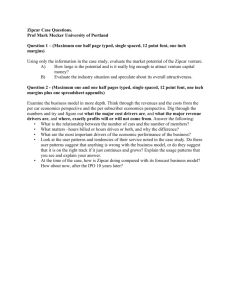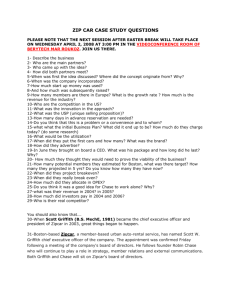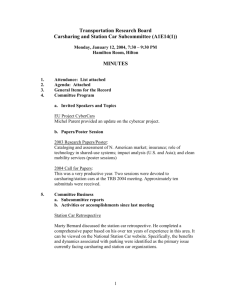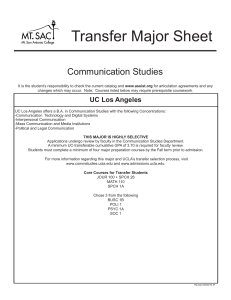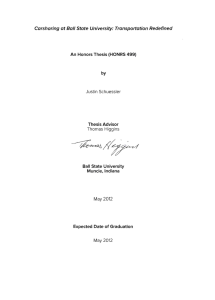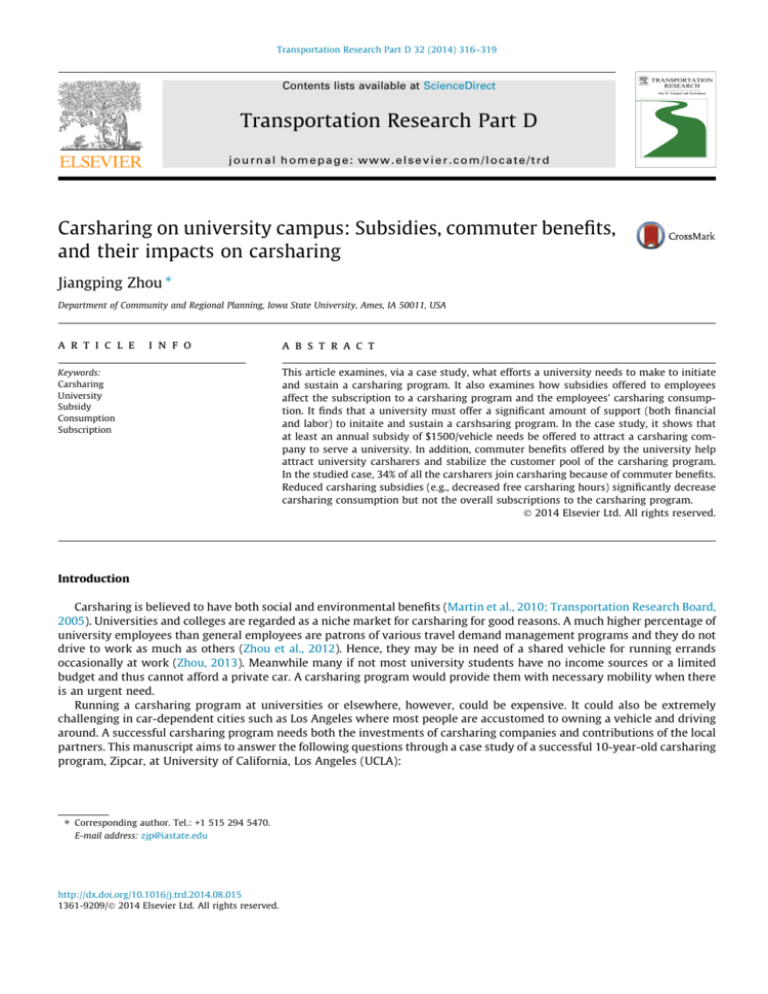
Transportation Research Part D 32 (2014) 316–319
Contents lists available at ScienceDirect
Transportation Research Part D
journal homepage: www.elsevier.com/locate/trd
Carsharing on university campus: Subsidies, commuter benefits,
and their impacts on carsharing
Jiangping Zhou ⇑
Department of Community and Regional Planning, Iowa State University, Ames, IA 50011, USA
a r t i c l e
i n f o
Keywords:
Carsharing
University
Subsidy
Consumption
Subscription
a b s t r a c t
This article examines, via a case study, what efforts a university needs to make to initiate
and sustain a carsharing program. It also examines how subsidies offered to employees
affect the subscription to a carsharing program and the employees’ carsharing consumption. It finds that a university must offer a significant amount of support (both financial
and labor) to initaite and sustain a carshsaring program. In the case study, it shows that
at least an annual subsidy of $1500/vehicle needs be offered to attract a carsharing company to serve a university. In addition, commuter benefits offered by the university help
attract university carsharers and stabilize the customer pool of the carsharing program.
In the studied case, 34% of all the carsharers join carsharing because of commuter benefits.
Reduced carsharing subsidies (e.g., decreased free carsharing hours) significantly decrease
carsharing consumption but not the overall subscriptions to the carsharing program.
Ó 2014 Elsevier Ltd. All rights reserved.
Introduction
Carsharing is believed to have both social and environmental benefits (Martin et al., 2010; Transportation Research Board,
2005). Universities and colleges are regarded as a niche market for carsharing for good reasons. A much higher percentage of
university employees than general employees are patrons of various travel demand management programs and they do not
drive to work as much as others (Zhou et al., 2012). Hence, they may be in need of a shared vehicle for running errands
occasionally at work (Zhou, 2013). Meanwhile many if not most university students have no income sources or a limited
budget and thus cannot afford a private car. A carsharing program would provide them with necessary mobility when there
is an urgent need.
Running a carsharing program at universities or elsewhere, however, could be expensive. It could also be extremely
challenging in car-dependent cities such as Los Angeles where most people are accustomed to owning a vehicle and driving
around. A successful carsharing program needs both the investments of carsharing companies and contributions of the local
partners. This manuscript aims to answer the following questions through a case study of a successful 10-year-old carsharing
program, Zipcar, at University of California, Los Angeles (UCLA):
⇑ Corresponding author. Tel.: +1 515 294 5470.
E-mail address: zjp@iastate.edu
http://dx.doi.org/10.1016/j.trd.2014.08.015
1361-9209/Ó 2014 Elsevier Ltd. All rights reserved.
J. Zhou / Transportation Research Part D 32 (2014) 316–319
317
1. What efforts has UCLA made over the years to initiate and sustain the Zipcar program1? Here, we focus on the financial
subsides provided by UCLA, in particular, in the form of free carsharing hours for eligible employees and free parking spaces
for shared vehicles on campus.
2. Have the free hours boosted the Zipcar membership and consumption? In January 2011, UCLA reduced the free hours
from 8 to 4 per month. Has this change influenced the Zipcar subscriptions and usage? If so, to what degree? In other
words, what is the change in the overall Zipcar consumption relative to the reduction in free hours offered to Zipcar
members?
3. Based on the above, what efforts should a large-employer like UCLA (or a city) make to initiate and sustain a successful
carsharing program?
This manuscript is a continuation of Zhou (2013), which focuses on university carsharers and their carsharing behaviors.
This short communication deals with issues that Zhou (2013) does not address, in particular, the costs for the employer to
provide carsharing services and the effects of subsidies provided by the employer on carsharing consumption among
employees.
Data and methods
The data for this study primarily come from anonymous UCLA Zipcar user invoices dated between 2009 and 2012. These
invoices detail who were subsidized Zipcar members at UCLA, who quitted and when, who used Zipcar and which vehicle,
when and how long. The data record how much UCLA spent in subsidizing free hours for whom each month. They report the
mileage consumed of each reservation by member. UCLA Zipcar master invoice 2008 is also used, which is slightly different
from the above invoices. This invoice only shows the number of subsidized Zipcar members at UCLA who used Zipcar and the
total hours and mileage they consumed each month in 2008.
This study as a whole is a case study, within which both quantitative and qualitative methods are adopted to analyze the
research data. UCLA Zipcar user invoices were used to perform the quantitative analysis. Two extra data, UCLA’s public
archives and the UCLA 2010 Carsharing Employee Survey (n = 125, response rate = 50%), were used for the qualitative
analysis.
Costs to initiate and sustain a carsharing program
UCLA offers 13 free parking spots to Zipcar vehicles and subsidizes eligible employees (called ‘‘alternative commuters’’ at
UCLA) certain free hours of Zipcar services each month. An employee needs to meet two criteria to become an alternative
commuter:
Having a UCLA appointment of at least 40% time.
Not possessing a UCLA parking permit.
Before January 2011, UCLA offered 8 free hours each month to alternative commuters. These free hours, if unused for the
given month, cannot be rolled over to another month. Per the agreement between UCLA and Zipcar, an alternative commuter
does not need to pay an annual fee for using Zipcar services. The 8 h were reduced to 4 since January 2011.
We consider the total of the lost parking revenues due to the free parking spots and the subsidies to alternative commuters as the minimum costs to initiate and sustain the Zipcar program. We ignore labor costs of UCLA employees who help
administrate Zipcar. We also overlook the possibility that due to the introduction of Zipcar to UCLA, some employees
may forgo their on-campus parking permits, which can potentially decrease the overall parking revenue at UCLA.
In 2010, the gross parking revenue generated by 13 parking spots at UCLA was $11,232. UCLA forgoes the revenue for
Zipcar. Meanwhile alternative commuters consumed 827.5 ‘‘free’’ hours of Zipcar services that UCLA subsidized in 2010.
Given that each hour cost UCLA $10, the university paid a total of $8275 out of its pocket. Thus, the minimum costs for UCLA
to initiate and sustain Zipcar on campus are $19,507 per year, combining the lost parking revenue and the payment for subsidized Zipcar hours. Putting the above information together, we find that UCLA has to subsidize each Zipcar vehicle about
$1500 annually.
Why does UCLA subsidize Zipcar? An important reason is to reduce demand for extra parking and consequently save costs
for building extra parking structures on campus. Actually, several recent subterranean parking lots at UCLA, such as the Ronald Reagan Medical Center Parking and the Parking Structure 7, cost the university millions of dollars. According to Shoup
(1997a), the cost of an additional parking space at UCLA was already $23,000 in 1994 dollars. What’s more challenging is
that, as UCLA’s campus cannot grow for various reasons, its space becomes even scarcer as the university attracts more students, visitors, and employees. Recently, to make room for a long-waited conference center on campus, UCLA has torn down
a parking structure in the center of its campus. Like it or not, the competition for space between parking and core functions of
1
Here, we assume that with UCLA’s contributions, the private company which operates Zipcar at UCLA would at least break even financially. We tried but
never succeeded in accessing any financial data on Zipcar’s actual costs at UCLA. Since the company continues running Zipcar at UCLA, it is realistic to assume
that it at least breaks even financially.
318
J. Zhou / Transportation Research Part D 32 (2014) 316–319
the university has become intense than ever at UCLA. At UCLA and other universities, parking issues are highly sensitive and
political too (Shoup, 2008). Carsharing tends provide a neutral way for those who drive to the campus and who do not drive.
The above-mentioned subsidies to Zipcar, however, are not all the costs for UCLA to sustain the program. UCLA offers
commuter benefits for alternative commuters, including a discounted price for occasional parking on the campus, emergency
ride home, pre-tax deduction of transit pass expenditure, and employer-subsidized transit pass for its employees. According
to the UCLA 2010 Carsharing Employee Survey, as many as 34% of the employees indicate that those commuter benefits significantly influence their participation in and usage of the carsharing program. Moreover, the results of the survey illustrate
that commuter benefits can also significantly affect the behaviors of the university carsharers: their frequency and quantity
of carsharing and when to carshare (Zhou, 2013). Due to the fact that no systematic data have been collected about the costs
of the commuter benefits, we do not know how much more UCLA spent on commuter benefits after the introduction of
Zipcar.
Impact of subsidies on carsharing behaviors
Using the data of the Zipcar user invoices, we found that alternative commuters on average only consumed 34% of the
hours that the other employee carsharers did. In other words, subsidies to or free hours for alternative commuters do not
encourage more carsharing consumption among them. It is also likely that alternative commuters have been a group of people who have been accustomed to the lifestyle without a car or with little driving.
Since January 2011, UCLA reduced free hours from 8 to 4 per month for alternative commuters. The Zipcar subscriptions,
however, were not affected by this change. Actually more employees subscribed to Zipcar and became alternative commuters after the change. Between February 2011 and October 2011, for instance, 149 more employees subscribed to Zipcar and
were classified as alternative commuters at UCLA.
Somewhat surprisingly, we found that not all alternative commuters use carsharing services. For instance, there were 250
active alternative commuters at the peak in 2010, among who only 85 actually used Zipcar in August 2010. In 2011, there
were over 350 alternative commuters at the peak, among who only 86 used Zipcar in June 2011. Considering the fact that
free hours for alternative commuters were reduced from 8 to 4 since January 2011, we find that the reduction of free hours
has significantly decreased the Zipcar consumption among alternative commuters as a whole. In the first nine months of
2010 and 2011, total Zipcar hours consumed by alternative commuters were 3712 and 2646 h, respectively. Thus, the overall
‘‘elasticity of demand’’ for Zipcar, which measures changes in the overall Zipcar consumption relative to the decreased free
(subsidized) hours for alternative commuters, is as high as 0.57. This indicates that alternative commuters either have
other transportation mode alternatives to Zipcar or have substitutes of activities that do not require driving. As we know
that there were more alternative commuters in 2011 than in 2010, the actual average demand for Zipcar services should
be more elastic to the changes in free hours than we described above.
Conclusions
The success of a carsharing program relies heavily on identifying and penetrating into niche markets. This manuscript
analyzes how local entities (especially large employers like universities) can help carsharing companies materialize the
potential of a niche market: university campuses or workplaces with a large number of employees. Some generalizable findings based on the case study are:
(a) Incentives for example free hours of carsharing should be bundled with other commuter benefits to effectively attract
participants to a carsharing program and to affect carsharers’ behaviors. In the UCLA case, 34% of the carsharers indicate that commuter benefits attracted them to Zipcar.
(b) Free hours of carsharing services don’t necessarily encourage more carsharing consumption, especially among those
carsharers who do not drive to work or rarely drive. Thus, if a policy goal is to encourage more carsharing consumption
so as to sustain a carsharing program, free hours and the dedicated budget set aside for them should be used carefully
as there are associated opportunity costs. Subscriptions to carsharing services tend to be uncorrelated to changes in
free hours. However, the consumption of carsharing services among employees who are eligible to free hours is highly
elastic to the changes. In summary, people always want a membership in a carsharing program for rainy days and this
membership tends not be affected by subsidies such as free hours associated with it.
(c) Not all subscribers of a carsharing program use the carsharing services, even those who are eligible for free hours of
carsharing. Although it is reasonable for the program administrator to set aside a budget sufficient to cover the maximum subsidized free hours, in light of the differences between the subscription and consumption, the administrator
can utilize the budget ‘‘surplus’’ with some flexibility. For instance, it could offer those eligible subscribers who never
or rarely use free hours a bigger discount for their transit passes, provide a free tune-up for their bicycles, and even
allow them to partially cash out their free hours, similar to the parking cash out program. This may incentivize all
subscribers to use free hours more frugally, compress, reduce or combine activities that require car usage, and use
alternative modes more frequently (c.f., Shoup, 1997b). If the employer wants to be more aggressive, the surplus
can even be used in conjunction with a program such as ‘‘Dump the Pump’’, which allows driving-alone employees
to try alternative modes for free for a given period (Zhou and Schweitzer, 2011).
J. Zhou / Transportation Research Part D 32 (2014) 316–319
319
References
Martin, E.W., Shaheen, S., Lidicker, J. 2010. Carshairng’s impact on household vehicle holdings: Results from a North American Shared-Use Vehicle Survey,
Transportation Research Board 2010 Annual Meeting, Washington D.C.
Shoup, D., 1997a. The high cost of free parking. J. Plan. Educ. Res. 17, 3–20.
Shoup, D., 1997b. Evaluating the effects of cashing out employer-paid parking: eight case studies. Transp Policy 4 (4), 201–216.
Shoup, D., 2008. The politics and economics of parking on campus. In: Ison, S., Rye, T. (Eds.), The implementation and effectiveness of travel demand
measures: an international perspective. Ashgate Publishing, Aldershot, UK.
Transportation Research Board, 2005. Car-sharing: where and how it succeeds. Transportation Research Board, Washington, D.C.
Zhou, J., Schweitzer, L., 2011. Getting drivers to switch: transit price and service quality. J. Urban Plan. Dev. 137 (4), 474–483.
Zhou, J., Wang, Y., Schweitzer, L., 2012. Jobs/housing balance and employer-based travel demand management program returns to scale: evidence from Los
Angeles. Transp. Policy 20, 22–35.
Zhou, J., 2013. Study of employee carsharing on the university campus. J. Urban Plan. Dev. 139 (4), 301–310.


